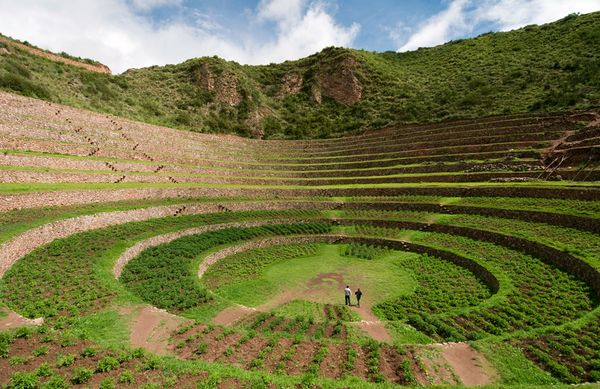A slideshow over at National Geographic features this image by photographer Ian Wood, showing, in the magazine’s own words, “what might be called extreme Inca landscaping.”
 [Image: The weather bowl at Moray, Peru; photo by Ian Wood/Alamy, courtesy of National Geographic].
[Image: The weather bowl at Moray, Peru; photo by Ian Wood/Alamy, courtesy of National Geographic].
“Three enormous pits, each with beautifully curved sides that staircase down like the interiors of titanic flowerpots have been carved out of the earth to depths of up to 100 feet and more,” the magazine adds. They are like Indian stepwells—only they concentrate thermal gradients—and this affects the local weather: “Air temperatures between the top and bottom layers can differ by more than 20 degrees, which has led some researchers to theorize that Moray was an Inca agricultural site where experiments on crops were conducted.”
It’s a site of experimental agriculture fueled by an act of microclimatic terrain deformation.
So does this mean that the weather at Moray should be subject not only to meteorological analysis, but to archaeological interpretation? The site you’re excavating seamlessly continues into the sky above it, turning the weather itself into an historic artifact—a whole new spin on paleotempestology.
But is the weather created by an historic site also part of that historic site? If so, should ancient microclimates such as these be subject to material preservation? Put another way, if there were a Museum of Ancient Microclimates, how would you design it and what would the visitor experience be?
Imagine a whole constellation of these oversized weather pits, meanwhile, distributed throughout the Andes, all interacting with and augmenting one another, producing continent-scale storm systems—and imagine being hit by a summer downpour, or sitting calmly throughout the winter as blizzards rage just one valley over, knowing that the atmospheric events around you are really long-lasting cultural gifts of the people who lived there centuries before. Weather designed by your ancestors still rages around you today.
 [Image: From Sietch Nevada by Matsys; renderings by Nenad Katic].
[Image: From Sietch Nevada by Matsys; renderings by Nenad Katic].
Superficially, I’m reminded of the hexagonal “water storage banks” of Sietch Nevada, a speculative design by the San Francisco-based firm MATSYS. While the resemblance doesn’t go much beyond form, this comparison lets us borrow MATSYS’s idea of a water bank and, thus, reinterpret the Incan site at Moray as a kind of weather bank, storing temperatures and headwinds year round. It is a space to store climates in.
Extrapolating wildly from this, if the rise of the Himalayas radically altered the earth’s climate by changing weather patterns for thousands of miles in all directions, then perhaps we can imagine a scenario in which a network of artificial pits in the Andes begins to affect the jet stream, plunging Australia into drought and pushing rain far north into Mexico—and that, in turns out, is those pits’ very purpose, having been excavated by scientifically advanced, self-styled weather warriors more than 600 years ago for reasons still unclear today. Groups of elders would get together in the dark, sitting around their pits in tight circles as the winds picked up, burning incense, singing tales, hurling storms like artillery into the central Pacific.
(Thanks to Marilyn Terrell for the heads up!)

The California Academy of Sciences (in San Francisco) has a four-story dome containing a simulated rainforest:
http://www.calacademy.org/academy/exhibits/rainforest/
Would the pit in the first photo from National Geographic be more about water or temperature? The configuration of it would seem to allow for more efficient use of water especially if rain collection cisterns were included at the top. Brad Lancaster just did a blog post on rain catchment systems in the Middle East: http://www.harvestingrainwater.com/2011/07/08/roman-and-byzantine-era-cisterns-of-the-past-reviving-life-in-the-present/. It would seem for temperatures the bowl would be warmer during the day and cooler at night. The stone retaining walls would also create more well drained beds and warmer soil conditions along the walls. It sure is a beautiful site and is a good example of how landscape can be manipulated for human purposes.
That first photo looks a lot like someone has been busy with a copy of Minecraft 🙂
We visited Moray a couple of years ago. It is truly amazing. The scope and size of the facility has to be visited to be appreciated. The Incas did some amazing things in their brief history as an empire.
http://bigblueglobe.blogspot.com/2009/06/pretty-amazing.html
Speaking of "man-made" weather, isn't that the goal of spending on expensive technology to create artificial wavepools, indoor snowfields or indoor resorts? Maybe our descendants in the far future will discover our Dubai Snowparks or Asian resorts and they will say that our generation have mastered the science of creating artificial weather.
Although what's amazing with the Inca landscaping is their utilization of natural topology of the land to create their mini-climate.
Please also see the Underground Gardens of Baldassare Forestiere in Fresno California.